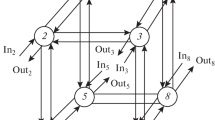Abstract
This paper describes Parallel Proto (PProto), an integrated environment for constructing prototypes of parallel programs. Using functional and performance modeling of dataflow specifications, PProto assists in analysis of high-level software and hardware architectural tradeoffs. Facilities provided by PProto include a visual language and an editor for describing hierarchical dataflow graphs, a resource modeling tool for creating parallel architectures, mechanisms for mapping software components to hardware components, an interactive simulator for prototype interpretation, and a reuse capability. The simulator contains components for instrumenting, animating, debugging, and displaying results of functional and performance models. The Pproto environment is built on top of a substrate for managing user interfaces and database objects to provide consistent views of design objects across system tools.
Similar content being viewed by others
References
R. D. Acosta, “Simulation of modeling parallel programs in PProto,”Proc. 1991 Summer comput. Simulation Conf., pp. 307–312 July 22–24, 1991.
R. D. Acosta and A. Guzmán, “An environment for functional and performance prototyping of parallel programs,”Collected Papers of the 1991 Workshop on Hardware/Software codesign, Thirteenth International Conference on Software Engineering, MCC Technical Report No. MCC-CAD-156-91, Microelectronics and Computer Technology Corporation, Austin, TX, May 13, 1991.
D. Hartman, “Functional description for the C3I reusable specification,” Air Force Contract No. F30602-88-C-0029, Technical Report No. ISSI-C88A00002-DRAFT, International Software Systems Inc., Austin, TX, June 1989.
M. Konrad and D. Hartman, “Functional description for Proto,” Air Force Contract No. F30602-85-C-0124, Rome Air Development Center, Griffiss AFB NY, January 1988.
C. D. Callahan, K. D. Cooper, R. T. Hood, K. Kennedy, and L. Torczon, “ParaScope: A parallel programming environment,”Int. J. Supercomput. Appl. vol. 2, no. 4, pp. 84–99, Winter 1988.
T. Lehr, Z. Segall, D. F. Vrsalovic, E. Caplan, A. L. Chung, and C. E. Fineman, “Visualizing performance debugging,”Computer, vol. 22, no. 10, pp. 38–51, October 1989.
V. A. Guarna, D. Gannon, D. Jablonowsky, A. D. Malony, and Y. Gaur, “Faust: An intergrated environment for parallel programming,”IEEE Software, vol. 6, no. 4, pp. 20–26, July 1989.
B. P. Miller, M. Clark, J. Hollingsworth, S. Kierstead, S.-S. Lim, and T. Torzewski, “IPS-2: The second generation of a parallel program measurement system,”IEEE Trans. Parallel Dist. Syst., vol. 1, no. 2, pp. 206–217, April 1990.
J. C. Browne, M. Axam, and S. Sobek, “CODE: A unified approach to parallel programming,”IEEE Software vol. 6, no. 4, pp. 10–18, July 1989.
J. C. Browne, T. Lee, and J. Werth, “Experimental evaluation of a reusability-oriented parallel programming environment,”IEEE Trans. Software Eng. vol. 16, no. 2, pp. 111–120, February 1990.
J. C. Yan, “Post-game analysis—A heuristic resource management framework for concurrent systems,” Ph. D. Dissertation, Technical Report No. CSL-TR-88-374, Computer Systems Laboratory, Departments of Electrical Engineering and Computer Science, Stanford University, Stanford, CA, December 1988.
J. C. Yan and S. F. Lundstrom, “The post-game analysis framework-Developing resource management strategies for concurrent systems,”IEEE Trans. Knowledge Data Eng. vol. 1, no. 3, pp. 293–308, September 1989.
D. Pease, A. Ghafoor, I. Ahmad, D. L. Andrews, K. Foudil-Bey, T. E. Karpinski, M. Mikki, and M. Zerrouki, “PAWS: A performance evaluation tool for parallel computing systems,”Computer, vol. 24, no. 1, pp. 18–29, January 1991.
SES, “SES/workbench introductory overview,” Scientific and Engineering Software, Inc., Austin, TX, April 1989.
E. C. Russell, “SIMSCRIPT II. 5 and SIMANIMATION: A tutorial,” inProc. 1987 Winter Simulation Conf., A. Thesen, H. Grant, and W. D. Kelton, eds., pp. 102–111, 1987.
A. V. Aho, J. E. Hopcroft, and J. D. Ullman,Data Structures and Algorithms, Addison-Wesley: Reading, MA, 1983, pp. 208–212.
R. Brown, “Calendar queues: A fast O(1) priority queue implementation for the simulation event set problem,”Commun. ACM vol. 31, no. 10, pp. 1220–1227, October 1988.
M. G. Staskauskas, “The formal specification and design of a distributed electronic funds-transfer system,”IEEE Trans. Comput. vol. 37, no. 12, pp. 1515–1528, December 1988.
Author information
Authors and Affiliations
Rights and permissions
About this article
Cite this article
Acosta, R.D. PProto: An environment for prototyping parallel programs. Journal of Systems Integration 1, 339–365 (1991). https://doi.org/10.1007/BF02262720
Received:
Revised:
Issue Date:
DOI: https://doi.org/10.1007/BF02262720




